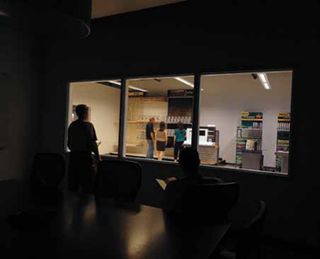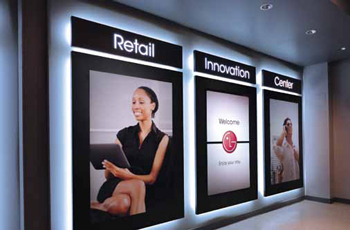New Tools to Help Link Shopper Marketing Research to Execution
AMD Industries, which specializes in designing, engineering, and producing retail marketing programs, has set up the new Retail Innovation Center (RIC) which is a highly collaborative and inspirational test and learn environment for developing and fine tuning retail executions.
Today brand marketers find themselves at a dichotomous moment between two economic epochs: not fully beyond what has been defined as the “attraction economy” but not entirely acculturated to the “participation economy” either. Creating a compelling retail experience in this space requires focus on the “experience.” Retail needs to transform itself into a place where consumers go to learn, be entertained, connect with others, share ideas or experiences, solve issues, try out new products, take advantage of special offers, and more. Although various communications technologies have made the world flatter, and have linked consumers socially to each other and economically to retail enterprises, adoption of these devices is not yet universal. What has become universal however is the need to establish visceral and emotional connections with brands. That is in fact becoming as important as the brand’s features and benefits are to influencing the shopping decision. Kevin Roberts, Global CEO for Saatchi & Saatchi explains:
“What consumers want now is an emotional connection…. The brands that can move to that emotional level, that can create loyalty beyond reason, are going to be the brands where premium profits lie.”
Whether or not we can define precisely why some retail experiences seem vastly more satisfying than others, I think we can agree that a handful of our shopping experiences have simply made us feel better than others. The brand and/or retailer has somehow better understood what matters to us, or has expressed their offer to us in a more creatively immersive way. In either case they have attracted (pulled) us to their brand with a superior experience. Sometimes they have leveraged highly engaging communications technologies to attract, but at other times have relied on simple principals of good brand storytelling artfully executed.
What is required of brand marketers today is a process for turning a few key shopper insights into a more compelling in-store experience. Unlike the common practice of compiling reams of empirical data for analysis and ultimately paralysis, the bias here is on the big idea, underpinned by a few choice data points, that is nimble enough to really be executed. It’s the difference between applied versus theoretical shopper marketing. As unprecedented competition at retail makes speed to market paramount, a more streamlined process is required. Critical for success is the alignment of key stakeholders, which becomes decidedly less likely when the volume of data exceeds critical mass. Far better to have decision makers rally around 2-3 key observations they share in a controlled setting and then pull the trigger decisively.
The Retail Innovation Center
At AMD Industries, which specializes in designing, engineering, and producing retail marketing programs, we have set up a way to meet this challenge head on, with our new Retail Innovation Center (RIC). The RIC is a highly collaborative and inspirational test and learn environment for developing and fine tuning retail executions. The RIC is a multi-purpose retail testing facility that supports client/ agency collaboration in both physical and virtual space.
The facility offers our clients an offsite venue where as many or as few key stakeholders can contribute in a handson way to optimizing retail marketing strategies. The Center provides platforms for research, prototyping, training webinars, focus groups, videoconferencing, and retail environment product sampling and demonstration.
The facility is comprised of three distinct areas that can be used independently or combined to put strategic concepts through their paces more completely. They are:
• Retail Innovation Lab: An in-store marketing playground that provides a tactile opportunity for clients to understand the materials, technologies, and design ingredients that may ultimately support the desired merchandising and or display concept.
• Experience Center: A facility that is used to emulate general retail environments for contextualizing specific merchandising implementations.
• Visualization Center: A facility that can project specific retail environments in virtual space as a backdrop against which merchandising concepts can be evaluated in context.

The Experience Center is a facility that is used to emulate general retail environments for contextualizing specific merchandising implementations. It offers AMD clients an off-site venue where as many or as few key stakeholders can contribute in a hands-on way to optimizing retail marketing strategies.
AMD is beginning to fully integrate the RIC into our overall retail marketing process. Activities conducted there can be logically inserted along a more traditional continuum of planning steps in a variety of places. After retail and brand audits but before a creative brief, we may wish to discover how real shoppers actually shop a product category by inviting test subjects to shop the selection set in the “Experience Center” while we observe. After initial concept renderings but before prototypes, our collaborators may want to place creative concepts into a variety of virtual retail environments in actual scale for more real world context. In the earliest stages of design development, we may wish to invite our client(s) in to the Innovation lab to collaborate with us on material selection and color palette.
When independent shopper research is required, clients may bring in their own research professionals and use the Center strictly as a venue or ask us to arrange a more turnkey package for which we bring in the appropriate AMD partner organizations.
Because the RIC is located in the heart of our headquarters facility within our manufacturing plant, it provides us with a unique advantage to bring physical concept prototypes into play quickly and to make modifications in real time. If time is money, and of course it is, this capacity to fine tune without significant delay is enormous strategically. The adjacencies of the rooms add additional synergies. For example, collaborators reviewing physical components in context may find it useful to circle back to the Innovation Lab to gather alternative samples for comparison or discussion. In this way they may see how proposed changes impact a program aesthetically and what price impact there may be.
This bundling saves time and money to be sure, but it also gives considerable continuity to the process. How many times have marketers found one element, focus group testing for instance, separated from another key element by weeks or months contributing to a very disconnected process or perhaps even killing a program out as means and opportunity have passed them by before step 2 is taken? At retail there will be winners and losers. Winners are those that bring the best ideas to market most cost effectively and most decisively.
Clients relate to us how important is to have access to an offsite test and learn facility in which they can better control attendance. Practically speaking it is difficult enough to create effective retail marketing programs without having an endless stream of “decision makers” weighing in on work in progress. Real stakeholders can attend RIC events in person or can be involved as needed via videoconferencing. The RIC also represents neutral territory when brands wish to collaborate with retailers in an environment comfortable for both parties or when either/ or both parties believe a degree of secrecy is in order.
In recent years both manufacturers and retailers have come to embrace the notion of shopper marketing but have failed to achieve a consensus on best practices. Though these stakeholders are awash in raw data about shopper behavior, more of a theoretical than practical paradigm has emerged creating more questions than hard answers about what strategies and tactics best influence shopper behavior. Outcomes are randomly only as good as the theories they are based on, and there emerges no discernable pathway to bankable retail marketing success. Lots of money is being spent but cause remains hopelessly disconnected from effect.
It is our contention that within today’s dynamic retail environments and with the level of competition for the shopper’s attention at a historic peak, shopper marketing research must be more closely linked with execution.
We also believe that great shopper experiences are based on brand story telling artfully designed and emotionally compelling. The metrics for success are about attraction, and attraction is about stories told with real human conviction. Aim your retail marketing process at discovering a few key shopper insights around which you can spin a big idea and then execute, execute, execute.
Matt Baker (bakerm@amdpop.com) is director of business development for AMD Industries, a leading U.S. POP display producer where he is responsible for marketing communications, new business client presentations, and overseeing the Retail Innovation Center.











